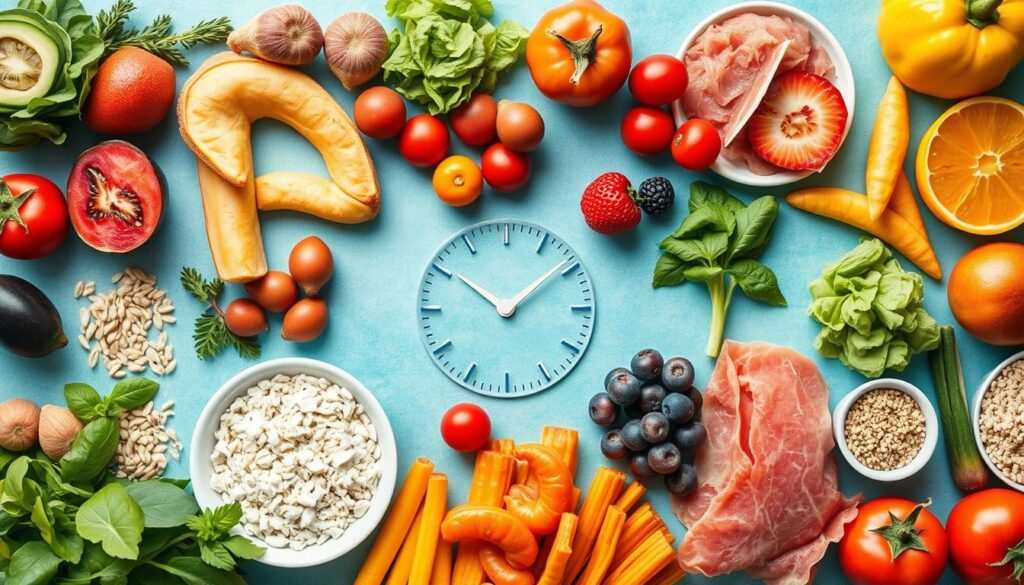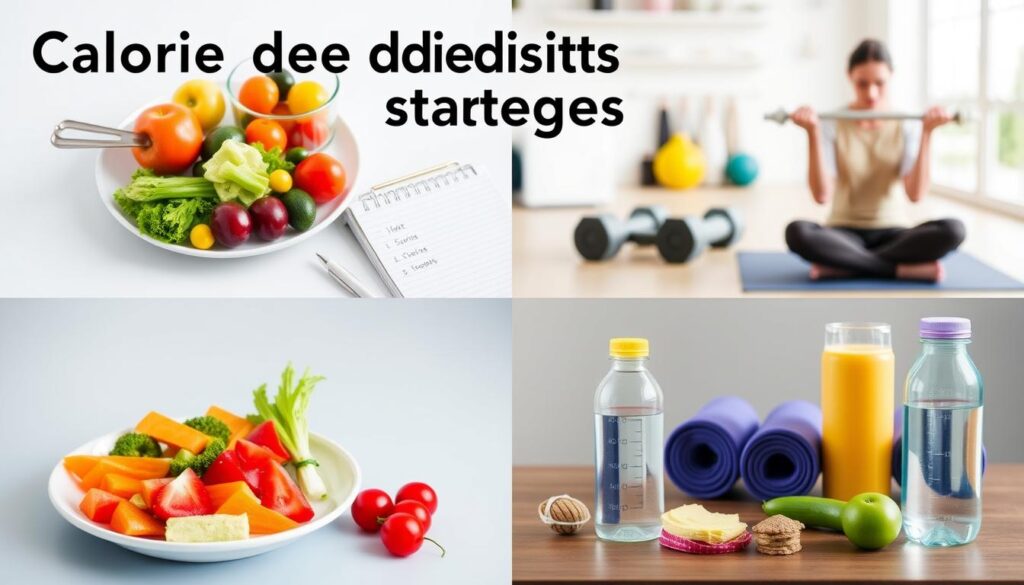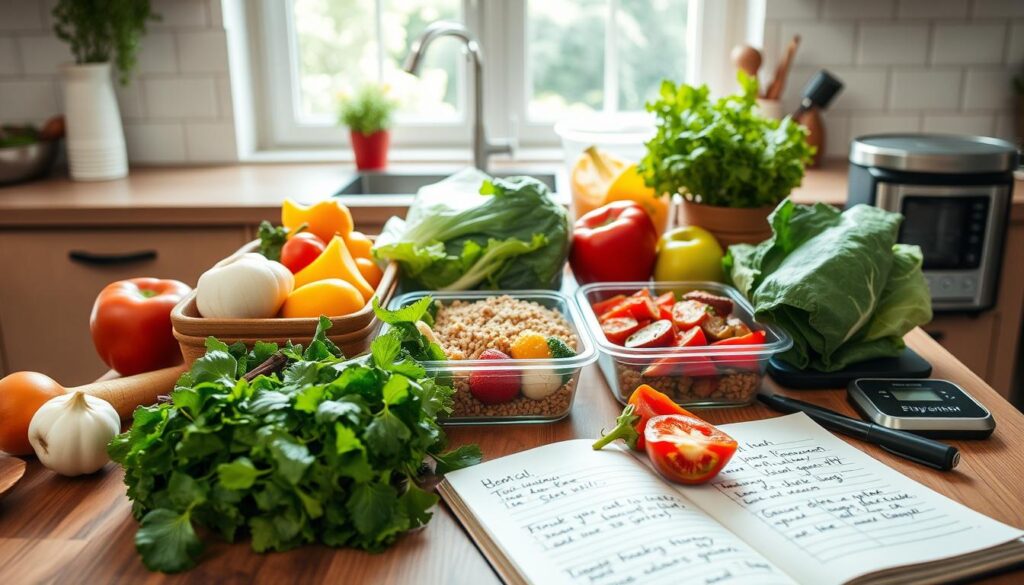Ever wondered why some people lose weight easily while others struggle? It might all come down to a calorie deficit. This is when you eat fewer calories than your body needs. It’s a key to losing weight safely and effectively.
We’ll dive into how to use calorie deficits for weight loss. We’ll also focus on keeping your health in check. This way, you can lose weight without harming your body.

Understanding the Calorie Deficit
A calorie deficit is key to losing weight. It happens when you burn more calories than you eat. This balance is important for losing weight and staying healthy.
What is a Calorie Deficit?
A calorie deficit means your body uses more calories than it gets from food. This makes your body use stored fat for energy. It’s a key part of losing weight.
It’s important to keep track of how many calories you eat and burn. This helps you understand if you’re in a calorie deficit.
The Science Behind Weight Loss and Energy Balance
Weight loss is all about energy balance. This means the calories you eat versus the calories you burn. Eating more calories than you burn leads to weight gain. A calorie deficit helps your body use fat for energy, leading to weight loss.
Studies show that sticking to a calorie deficit is key for losing fat and managing weight.
| Energy Balance | Outcome |
|---|---|
| Caloric Intake | Weight Loss (Calorie Deficit) |
| Caloric Intake = Caloric Expenditure | Maintenance (Stable Weight) |
| Caloric Intake > Caloric Expenditure | Weight Gain (Caloric Surplus) |
Understanding these concepts is crucial for making smart diet and lifestyle choices. Adopting a calorie deficit helps you reach your weight loss goals and promotes healthier habits.
How to Create a Calorie Deficit for Fat Loss
To lose fat, you need to create a calorie deficit. First, figure out how many calories you need each day. This guide will help you calculate your needs and show you how to eat fewer calories.
Understanding Your Daily Caloric Needs
Knowing your daily calorie needs is key for losing fat. Your age, gender, weight, height, and how active you are all play a part. The Harris-Benedict equation is a good way to estimate these needs.
Strategies to Reduce Caloric Intake
Once you know your calorie needs, it’s time to eat less. Here are some tips:
- Portion control: Eating smaller meals can greatly reduce your calorie intake.
- Opt for low-calorie foods: Choose veggies, fruits, and whole grains for meals. They’re full of nutrients but not too many calories.
- Mindful eating practices: Listen to your hunger and enjoy your food without distractions. This can help you avoid eating too much.

Using these tips, you can adjust your diet to meet your calorie needs and lose fat safely. Learning these strategies will help you on your weight loss journey.
Calorie Deficit Diet: A Comprehensive Overview
A sustainable calorie deficit diet requires careful planning. It ensures you get the nutrients you need while eating fewer calories. This diet focuses on a balanced mix of foods, promoting health and helping with weight loss.
Components of a Balanced Calorie Deficit Diet
A balanced calorie deficit diet includes several key components:
- Whole grains: Foods like quinoa, brown rice, and whole grain bread are full of fiber and energy.
- Lean proteins: Lean meats, fish, eggs, and plant-based proteins like beans help keep muscle mass during weight loss.
- Healthy fats: Foods such as avocados, nuts, and olive oil are good for the heart and keep you full.
- Fruits and vegetables: These are rich in vitamins, minerals, and antioxidants, making sure your diet is complete.
By balancing these food groups, you meet your dietary needs and create a calorie deficit. This is key for successful weight loss.
Popular Calorie Deficit Diet Plans
There are many popular diet plans that help you achieve a calorie deficit. Each has its own strategy:
| Diet Plan | Description | Benefits |
|---|---|---|
| Mediterranean Diet | Focuses on whole foods, healthy fats, and plant-based ingredients. | Improves heart health and supports weight loss through balanced nutrition. |
| Intermittent Fasting | Cycles between eating and fasting to reduce total caloric intake. | Promotes fat loss, improves metabolic health, and enhances cellular repair. |
| Ketogenic Diet | High-fat, low-carb diet that allows the body to enter ketosis. | May reduce hunger and help facilitate fat loss effectively. |
These diet plans show different ways to create a calorie deficit diet. They help you find a plan that fits your lifestyle and promotes healthy weight management.

Tracking Your Caloric Intake Effectively
Watching your calorie intake is key to losing weight. There are many ways to track calories, helping you make better food choices. A calorie deficit calculator is a useful tool for setting and tracking your daily calorie goals. It helps you understand the importance of proteins, fats, and carbs in your meals.
Controlling portion sizes is also crucial. It ensures you eat the right amount of food. Here are some effective ways to track your calories.
Using a Calorie Deficit Calculator
A calorie deficit calculator makes it easy to figure out your daily calorie needs for weight loss. Just enter your age, weight, height, and how active you are. It gives you a personalized calorie goal. This tool helps you stay on track with your calorie intake.
How to Track Your Macronutrients
Knowing about macronutrients is important for a balanced diet. Here are some tips:
- Identify Your Ratios: Find a balance of proteins, fats, and carbs that fits your life.
- Use Apps: There are apps that help track your macronutrient intake and give you feedback.
- Read Labels: Learn to read nutritional labels to manage your energy intake better.
Portion Control Techniques
Controlling your portions is key to managing calories. Try these methods:
- Use measuring cups and spoons for accurate portion sizes.
- Try eating off smaller plates to make your food look bigger.
- Listen to your body’s hunger signals and eat slowly to know when you’re full.
Meal Planning for a Successful Calorie Deficit
Meal planning is key to a successful calorie deficit. It helps you eat healthier and avoid bad food choices. A good meal plan includes nutritious foods and keeps your calorie intake in check.
Creating a Weekly Meal Plan
To make a good weekly meal plan, pick foods that are low in calories but high in nutrients. This helps you feel full and prevents cravings. Here’s how to do it:
- Choose foods from different groups like fruits, veggies, whole grains, lean proteins, and healthy fats.
- Plan meals for breakfast, lunch, dinner, and snacks. This keeps your energy up all day.
- Use seasonal produce for freshness and to save money.
- Batch cook meals or prep ingredients ahead of time to save time.
Incorporating Calorie Deficit Foods
Adding calorie deficit foods to your diet is crucial for losing fat and improving health. Foods like leafy greens, berries, quinoa, chicken breast, and legumes should be part of your diet. They keep you full and boost your nutrient intake. Here are some tips:
- Snack on fruits and veggies to increase fiber and feel full.
- Replace high-calorie ingredients with lighter ones, like Greek yogurt instead of sour cream.
- Use smaller plates to control portions and make meals look bigger.

| Day | Breakfast | Lunch | Dinner | Snack |
|---|---|---|---|---|
| Monday | Oatmeal with berries | Grilled chicken salad | Quinoa with steamed broccoli | Apple slices |
| Tuesday | Greek yogurt with honey | Vegetable stir-fry | Baked salmon with asparagus | Carrot sticks |
| Wednesday | Scrambled eggs with spinach | Turkey wrap with lettuce | Lentil soup | Mixed nuts |
| Thursday | Chia seed pudding | Quinoa salad | Stuffed bell peppers | Rice cakes |
| Friday | Smoothie with spinach | Brown rice with beans | Grilled shrimp with vegetables | Popcorn |
| Saturday | Pancakes with banana | Caprese salad | Veggie burger | Yogurt |
| Sunday | Muesli with nuts | Chicken and vegetable soup | Pasta with tomato sauce | Dark chocolate |
Enhancing Your Metabolism for Better Results
To get the best results in weight loss, focus on boosting your metabolism. A faster metabolic rate helps burn calories more efficiently. This can help you reach your fat loss goals. Adding certain foods and exercises to your routine can help your body burn fat better.
Foods That Boost Metabolism
Some foods can really help your metabolism. Here are a few examples:
- Protein-Rich Foods: Foods like chicken, fish, and legumes need more energy to digest. This means you burn more calories.
- Green Tea: Green tea has antioxidants and catechins that help burn fat and boost metabolism.
- Spices: Cayenne pepper and ginger can increase your metabolic rate. This helps burn more calories.
The Role of Exercise in Fat Burning
Exercise is key for boosting metabolism and burning fat. Doing both cardio and strength training is best. Cardio burns calories when you’re active. Strength training builds muscle, which raises your resting metabolic rate.
Adding a balanced fitness routine can help you lose fat better. Try to include:
| Type of Exercise | Benefits |
|---|---|
| Cardiovascular | Burns calories during activity, improves heart health |
| Strength Training | Builds muscle mass, increases resting metabolic rate |
| High-Intensity Interval Training (HIIT) | Boosts metabolism post-exercise, maximizes calorie burn |
By adding these foods and exercises to your daily routine, you can boost your metabolism. This will help you on your weight loss journey.
Conclusion
Understanding and using a calorie deficit is key for lasting weight loss. This article covered the basics of creating and keeping a calorie deficit. It also showed how to add fat loss strategies to your daily life.
Starting your weight loss journey can be easy with the right tools. Using a calorie deficit wisely can lead to lasting changes. Adding exercise and good nutrition boosts your metabolism, helping you reach your goals.
Every small step you take helps you succeed in your weight loss journey. By applying what you’ve learned, you can make choices that fit your life. Start using these tips to see the benefits of effective fat loss in your everyday life!
FAQ
What is a calorie deficit and why is it important for weight loss?
A calorie deficit means you eat fewer calories than your body burns. It’s key for losing weight. Your body then uses fat for energy, helping you lose weight slowly.
How can I determine my daily caloric needs?
To find your daily caloric needs, use the Harris-Benedict equation or online calculators. These tools look at your age, gender, weight, height, and activity level. They give you a personalized estimate.
What are some effective strategies to reduce caloric intake?
Effective ways to cut calories include portion control and choosing low-calorie foods. Mindful eating and meal planning also help. This way, you can ensure each meal is balanced and fits your calorie goals.
How do macronutrients affect my diet while in a calorie deficit?
Macronutrients like proteins, fats, and carbs are crucial in a calorie deficit diet. They help keep your energy up, support muscle, and make you feel full. This is important for losing weight in a healthy way.
What are some popular calorie deficit diet plans?
Popular diets include the Mediterranean, intermittent fasting, and the ketogenic diet. Each focuses on different foods but aims to keep you in a calorie deficit for fat loss.
How can I effectively track my caloric intake?
To track calories, use apps or a calorie deficit calculator. These tools let you log your food and see your progress. Keeping a food diary also helps you stay on track and aware of your eating.
What foods can help boost my metabolism?
Foods that boost metabolism include lean proteins, green tea, spicy foods, and whole grains. Adding these to your diet can help burn more calories and aid in weight loss.
What role does exercise play in achieving a calorie deficit?
Exercise is vital for a calorie deficit. It burns calories during and after workouts. This increases your metabolic rate, helping you burn calories even when resting.
How can meal planning aid in maintaining a calorie deficit?
Meal planning helps organize your food and choose healthier options. By planning meals, you can include foods that are low in calories but rich in nutrients. This promotes fullness and helps you stay on track with your goals.
